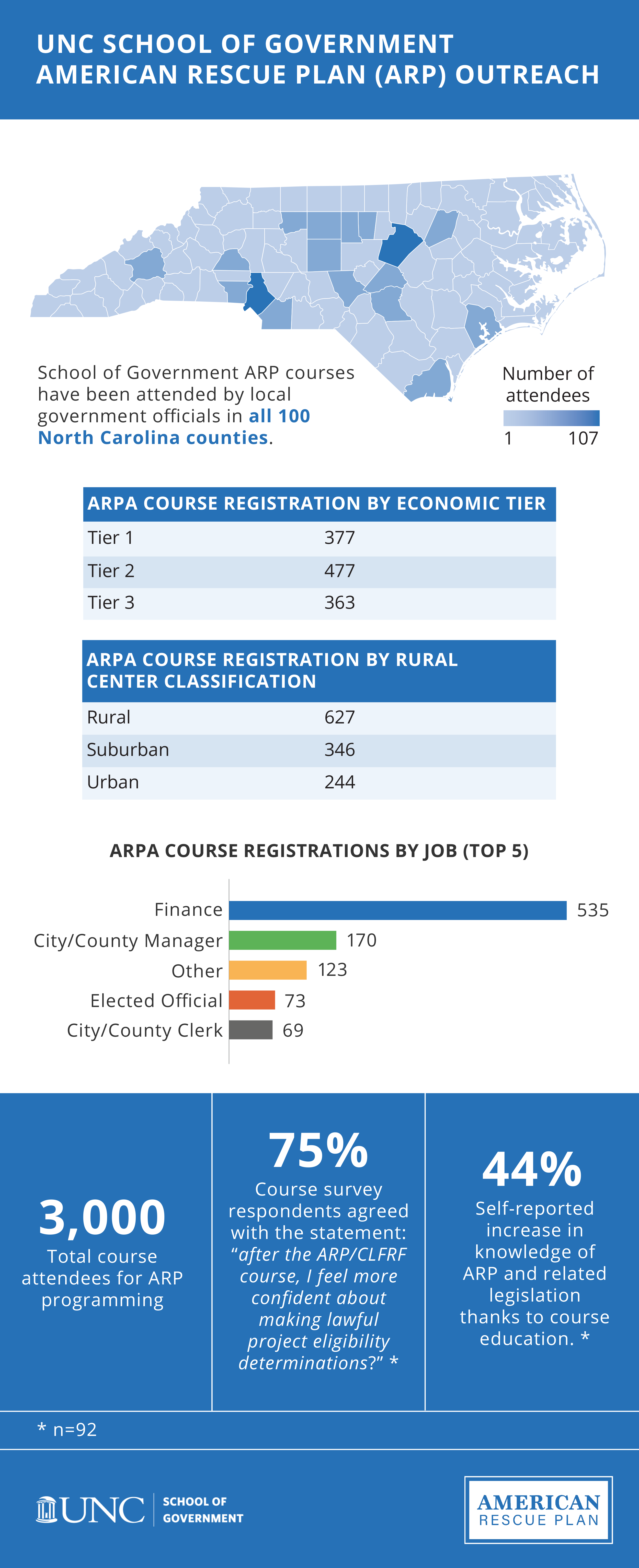Whether through personal stimulus checks, small business aid, or another program, many Americans are familiar with some type of U.S. federal action or legislation aimed at economic response to the COVID-19 pandemic. Many may be less aware of the impact of these programs on local and county governments and the associated challenges and opportunities they present to public officials.
Signed into law in March 2021, the American Rescue Plan Act (ARP) is one such piece of legislation. It totals $1.9 trillion and is the third major federal stimulus package passed in response to the pandemic. While the largest ARP program distributed personal stimulus checks, the next-largest program is aimed at providing critical funding to state, county, and municipal governments.
Understanding ARP is a daunting task for many local government officials. UNC School of Government faculty member Kara Millonzi is part of a School-wide and statewide collaborative effort to provide ongoing education, support, and advising for officials navigating these legislative requirements. The Robert W. Bradshaw Jr. Distinguished Professor of Public Law and Government, Millonzi has spent much of the past year helping local governments stay abreast of complex issues related to ARP.

What does the American Rescue Plan provide to local governments?
Kara Millonzi: One of the largest ARP programs is the $350 billion Coronavirus State and Local Fiscal Recovery Fund (CSLFRF). The CSLFRF provides funding over a two-year period to all states, counties, and municipalities across the country. North Carolina local governments received their first distribution—half of the total allocation—this past summer and fall and will receive the remaining funds this coming summer and fall.
Consistent with state law authority, the monies generally may be spent on certain projects that respond to the ongoing public health emergency or its negative economic effects; to replace lost revenue growth from 2020 through 2023; and to make investments in necessary water, wastewater, stormwater, and broadband infrastructure.
What are the major opportunities and challenges associated with ARP for North Carolina communities?
KM: For many local governments, these funds allow them to address pressing needs and make important longer-term investments in their communities, particularly benefiting individuals and areas that have been disproportionately negatively impacted by the pandemic. The challenges are myriad, though.
First, a local government must spend the funds consistent with the federal award and state law authority. We have been operating under an Interim Federal Rule, which comprises the regulations enacting the law, since May 2021, and there are a number of conflicting provisions and grey areas. Additionally, federal grants come with lots of strings. Local governments must follow the Uniform Guidance, which, among other things, requires units to adopt new policies and follow different process requirements related to property management, program income, procurement, and partnering with outside organizations. Many local governments will be required to undertake a more stringent audit process, and there are onerous documentation and retention requirements.
Finally, this is just one of many new grant programs. Local governments have opportunities that they’ve never had before to tap into federal and state monies, but it is overwhelming having to deal with all of this at once.
How has the School of Government supported communities attempting to navigate these requirements?
KM: When the law was enacted in March 2021, it was clear that North Carolina local governments were going to need help navigating the various federal requirements. In addition to our traditional research, writing, advising, and teaching, we launched free weekly office hours dedicated to the CSLFRF. The office hours began in July and, to date, attendance has topped 3,000 participants. During office hours, we’ve been able to respond to common questions, present on hot topics, and facilitate information sharing among local governments.
Although a valuable tool, we realized mid-summer that we needed to do more to provide a comprehensive overview of the requirements and to reach more local governments. In collaboration with various partner organizations, including the NC League of Municipalities, NC Association of County Commissioners, NC Department of State Treasurer, NC Department of Environmental Quality, NC Association of Regional Councils of Government, and NC Pandemic Recovery Office, we developed and presented a six-day virtual course on CSLFRF. The course was attended live by 1,229 local government officials, representing local governments in every county across the state. To maximize the reach of the course, we offered it free of charge.
The course covered the basics of CSLFRF and presented a project eligibility framework. It also detailed the various budgeting, auditing, reporting, and other compliance requirements associated with projects. Finally, it covered community engagement and performance and outcome measurements to help local governments make strategic decisions about their investments. The course continues to be available for free on demand.
What has made the School’s ARP outreach and support unique?
KM: One of the great aspects of our CSLFRF response has been the ongoing coordination and collaboration with our partner organizations across the state. Through office hours, regional presentations, and other outreach efforts, we have all worked closely to try to provide consistent and complete information and to represent the various constituencies.
What’s next for ARP education and support?
KM: We will continue to hold weekly office hours for the foreseeable future and post blogs to address new developments and frequently asked questions. Over the next few months, we also will continue to roll out sample policies and implementation templates to help local governments comply with the Uniform Guidance. When U.S. Treasury issues its Final Rule (update: this Final Rule was released on January 6, 2022) and/or if pending new federal legislation is enacted, we will likely offer a refresher course to ensure that local government officials have the latest information. We also are creating an online resource hub for ARP and CSLFRF and other federal grant programs.
Local government officials can access ARP resources and materials here.